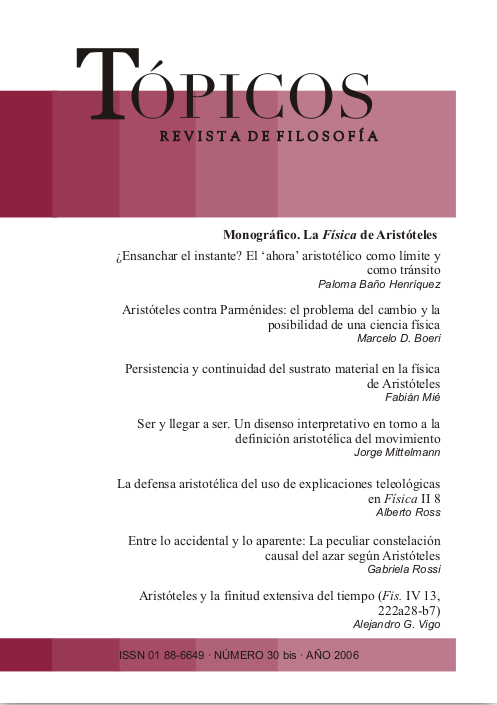Publicado 2013-11-28
Palabras clave
- Aristóteles,
- Física,
- tiempo,
- Heidegger.
Cómo citar
Resumen
Este artículo se propone examinar la concepción aristotélica del ‘ahora’, tal como se presenta en Física IV 10-14. La autora argumenta que en las dos cuestiones que Aristóteles aborda ahí (si el tiempo existe y qué es el tiempo) el ahora se comprende como límite interno del tiempo, una comprensión en la que el énfasis principal está puesto en la condición de indivisibilidad de tal límite o, dicho de otra manera, en el hecho de que el ‘ahora’ no es parte del tiempo. Baño se concentra en una analaogía presentada por Aristóteles para dar cuenta de la difícil tesis de que el ‘ahora’ es siempre el mismo y, al mismo tiempo, siempre diferente. La cuestión en la que la autora está especialmente interesada es el hecho de que el móvil no parece ser al movimiento lo mismo que el ‘ahora’ es al tiempo, dado que el móvil no es un límite interno del movimiento. Consecuentemente, la analogía no puede basarse en la condición puntual del ‘ahora’ y, más bien, parece basarse en el hecho de que el ‘ahora’ es un principio de cognoscibilidad del tiempo, tal como el móvil es un principio de cognoscibilidad del movimiento.
Descargas
Referencias
- Aristóteles. (1924). Metaphysics. W. D. Ross (ed.) Oxford: Clarendon Press.
- ____ (1975). Physics. W. D. Ross (ed.) Oxford: Clarendon Press.
- ____ (1994). Metafísica. T. Calvo (trad.) Madrid: Gredos.
- ____ (1995a). Física. G. R. De Echandía (trad.) Madrid.
- ____ (1995b). Física III-IV. A. G. Vigo (trad.) Buenos Aires.
- Conen, P. (1964). Die Zeittheorie des Aristoteles. München: C. H. Beck’sche Verlagbuchhandlung.
- De Aquino, T. (1965). In Octo Libros Physicorum Aristotelis Expositio. Roma: Marietti.
- ____ (1999). Commentary on Aristotle’s Physics. R. J. Blackwell, R. J. Spath and E. Thirlkel (ed.) Notre Dame, Indiana: Dumb Ox Books.
- Ellis, J. (2000). Heidegger, Aristotle, and Time in Basic Problems § 19. En Interrogating the Tradition. Hermeneutics and the History of Philosophy. Albany: State University of New York.
- Figal, G. (1988). Martin Heidegger. Phänomenologie der Freiheit. Weinheim: Beltz Atehnäum Verlag.
- Giannini, H. (2001). El pasar del tiempo y su medida. La temporalidad en Aristóteles, con comentario de Santo Tomás de Aquino y otras anotaciones. Santiago: Editorial Universitaria.
- Heidegger, M. (1927a). Gesamtausgabe. Band 24. Die Grundprobleme der Phänomenologie. Frankfurt: Vittorio Klostermann.
- ____ (2000). Los problemas fundamentales de la fenomenología. J. J. García (trad.) Madrid: Trotta.
- Parménides. (1985). El Poema de Parménides. A. Gómez-Lobo (trad.) Santiago: Editorial Universitaria.
- Platón. (1992). Timeo. Vol. 6. F. Lisi (trad.) Madrid: Gredos.
- Simplicius. (1992). On Aristotle Physics 4.1-5, 10-14. J. O. Urmson (trans.) London: Duckworth.
- Tortstrik, A. (1857). Hó pote ón. Ein Beitrag zur Kenntnis des aristotelischen Sprachgebrauchs. En Rheinisches Museum, 12: 161-173.
- Vigo, A. (2002). Indiferentismo ontológico y fenomenología en la Física de Aristóteles. En Nova Tellus, 20 (2): 119-171.
- Wieland, W. (1962). Die aristotelische Physik. Göttingen: Vandenhoeck & Ruprecht.






